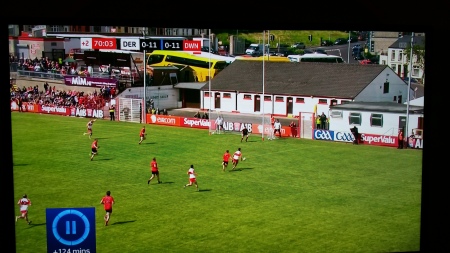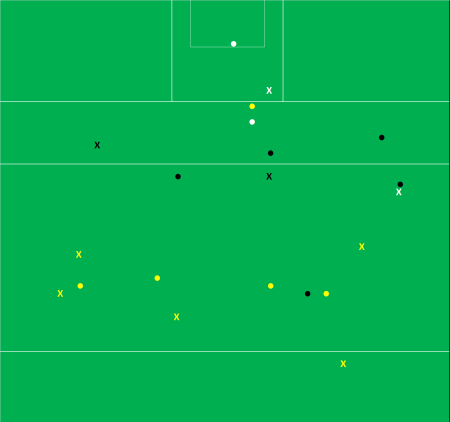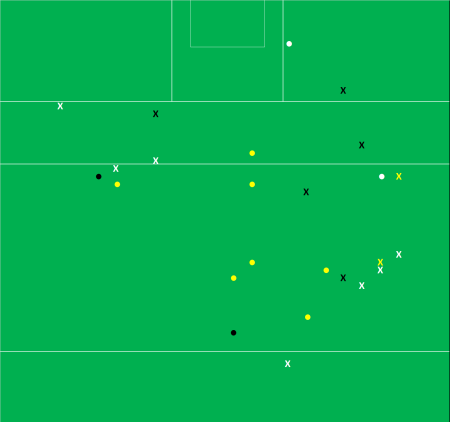This is the third game in the historic series (the 1985 All Ireland final between Kerry & Dublin can be found here whilst game4 of the 1991 Leinster series between Dublin and Meath can be found here) and a few observations highlighted in those games still hold true.
The game was different. The component parts – kickouts, fielding, shooting – were the same, and the current metrics we have for measuring them are probably a fair comparison, but the overarching principles that underlined how teams approached the game were different. Very different. Possession was not as important as it is now – clearing your lines was the first thought. This led to a lot more contested balls which in turn nullifies some of the metrics (points per possession, Attack Rates) we now view a game through (see note1).
In this game there were 113 team possessions with 31% of those possessions having just one player control the ball. 60% had no more than two players control the ball. No team possession had more than seven individual player possessions. This was very similar to that aforementioned 1991 game where there were 114 total possessions with 32% having one player possession, 63% having two player possessions and only one possession in the whole game having more than six individual player possessions (incidentally that was Kevin Foley’s goal!).
Compared to recent years? The four finals in the last three years have averaged 91 total possessions with 7% involving one player, 21% involving no more than two players and a whopping 35% with seven or more players controlling the ball. The game was different.
When Down had the ball
Overall Down had three fewer possessions throughout the game but managed to produce three more shots. (Incidentally that is now a clean sweep in these historic games for the team losing the possession count but winning the game). In and of itself this tells us something about that Down forward line; when they got the ball they were able to manufacture a shot. Again for the four finals in the last three years the Shot Rate (getting a shot off from possessions inside the 45) was 79.5%. Down produced a Shot Rate of 89% here.

Disc = score, X= miss; yellow = deadball, red = attempt on goal, black = point attempt from play 1st half, white = 2nd half
That Shot Rate was somewhat inflated by the sheer volume of deadball attempts – eleven in total (10x frees and 1x 45). Eleven is high both when compared to current trends (last two years have seen an average of 6.4 deadballs per team per game) and historically. The four teams in the previously mentioned historic games averaged 8.0 shots from deadballs per team. Greg McCartan had an off day from the ground returning 0-04 from 10 which is about 0-03 below (Expt pts -2.96) what the modern free takers would be expected to return (see note 2)
Given the shots they attempted Down were expected to score 1-18 (Expt pts of 21.5). We have touched on the poor returns from deadballs above but their shooting from play was more or less in line with modern returns (1-10 from 21; 52% Conversion Rate & Expt pts -0.74). They had three clear cut goal chances, which, incidentally, were their last three attempt from play, returning 1-00 leaving a stat line of 56% (0-10 from 18) and Expt Pts of -0.23 for point attempts from play. This is good shooting in an All-Ireland final (point attempts from play were 53% for the four finals from 2017) and, as we will touch upon below, was greatly aided by their decision making.
Mickey Linden was exceptional scoring 0-06 from 8 (Expt pts +1.41). Three with the right, two with the left and one fisted effort … all after missing a very simple fisted point with his first attempt. In the first half he was 0-05 from 7 whilst also being directly involved in the build up to two further shots. Derry got to grips with him in the second half, ostensibly by moving McKeever across to pick him up, however he was still pivotal getting out in front and shifting the ball with quick hands for McCabe’s goal and also letting the ball into the forward line for the Whitnall attempt that was pulled wide.
Part of Linden’s success was his link play with Aidan Farrell. Farrell, as the starting target man, “only” came away with 0-01, however he was the primary assist on six Down shots in the first half including 0-03 of Mickey Linden’s haul. In a nod to his flexibility, and ability, he was then brought further out to field to try and stymie the influence Gilligan & Tohill were having there.
McCabe must go down as one of the most impactful substitutes. He was only on the pitch for 10 minutes but was centrally involved in all three of Down’s goal attempts, which were condensed into a four minute period from the 63rd minute, whilst also shifting the ball to Whitnall who was then fouled for the last score of the game. Incidentally there is a great interview with him from 2019 here
When Derry had the ball
Derry were not as efficient as Down, either in terms of manufacturing shots from attacks (a shot rate of 78% versus 89% for Down), nor in converting those shots (a Conversion Rate of 45% versus 53% for Down).
Derry’s deadball returns were below what was expected (50%; 0-04 from 8 Expt pts -1.60) but not as poor as Down. Their goal attempts (1-01 from 2) also returned more than Down’s did. Which all leads to a very poor day on their point attempts.

Disc = score, X= miss; black = point attempt from play 1st half, white= 2nd half
Derry’s point attempts are outlined above. The majority of them came from “outside” where their accuracy fell apart in the second half; they missed all seven after going 0-03 from 5 in the first half. In fact when we compare the Down shots from play, versus the Derry ones, we can see a clear distinction.

Disc = score, X= miss; black = Derry point attempt from play, white = Down
A lot of Down’s comparative accuracy can be attributed to where the shots came from. The aforementioned decision making. Expanding the inside/outside zone (granted I have made this fit the argument but still …) Derry had 10 shots from outside the bulk of Down’s shots and scored just 0-02 from those 10 attempts. Inside both teams were more or less as accurate as each other; both returned 56% (Derry 0-05 from 9 and Down 0-09 from 15). Down’s chances were just heavily weighted to the more favourable scoring opportunities.
No one had a “Mickey Linden” day for Derry but Joe Brolly was very good. Not only did he convert both his attempts but he was also the primary assist in seven more shots including winning three frees and setting up McCusker for the goal
Kickouts
Generally speaking Derry dominated the kickouts. They gained 11 extra possessions (27 won versus 16 for Down) on the 43 kickouts without the volume being skewed towards them. They won 64% of their own kickouts (14 of 22) but also 62% of Down’s (13 of 21). They were dominant. Using current rules I had them claiming seven Marks, to Down’s three, with Gilligan & Tohill bagging three apiece (hence why Farrell was moved out)
But they didn’t turn this dominance into a scoreboard effect. Derry scored 0-05 directly off the kickout possessions won, which results in 0.19 points per possession (ppp). Down scored 1-05 from the 16 kickouts they won for 0.50 ppp
Unlike the modern game short kickouts were not really a “thing” with only five (12%) of the 43 kickouts dropping short of the 45. For context in the last four All-Ireland finals 58% of kickouts went short.
The kickout rules were different back in 1994. If a kickout was taken after a score it was taken from the 20m line. Otherwise it was taken from the edge of the small square. This had a huge variance on the length of the kickout and from Derry’s perspective the outcome. Below is their kickout chart with those kickouts post a score in white.

Disc = Derry gained possession, X= Down gained possession; white = after a score, black= after a wide
You can see that all bar three taken post a score made it past the 65 – basically onto Gilligan & Tohill – with two dropping just short of the 65. Derry dominated around the middle winning 10 of 14. But when the kickout was taken from the edge of the square Down managed to win 4 of 7 … three of these seven, circled in red, came in the last six minutes two of which led to the McCabe goal chances. Looking at the length of these three kickouts compared to the other four is it possible that the sheer volume of long kickouts emptied McCusker’s leg?
Note1
As an example of the differing emphasis there were 29 possessions started outside both team’s 65s in this game compared to an average of 7.75 over the past four All Ireland finals
Note2
This is another area, along with the possession count, that the modern day game distances itself from these historic games. And puts the accuracy of modern day free takers, such as Dean Rock and Séan O’Shea, into context. In the three historic games reviewed so far the teams combined for a deadball return of 49% (0-25 from 51). The average from the past five Championships was 72.6%. Rock, in the most pressurised of games, is running at 73% in All Ireland finals.
The three historic games’ deadballs are below. Now they have taken more long range pot shots than you are likely to see today but as a rule of thumb the target for current free takers is 85-90% “inside” and 50% “outside”. These historic returns are below expected on the “inside” (82%; 0-18 from 22) but well behind on the “outside” (24%; 0-07 from 29)




























